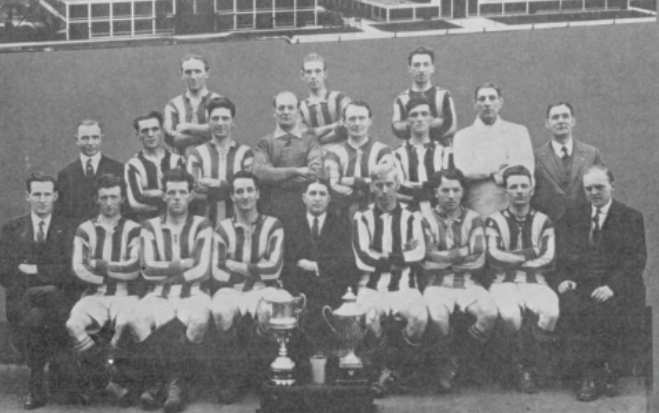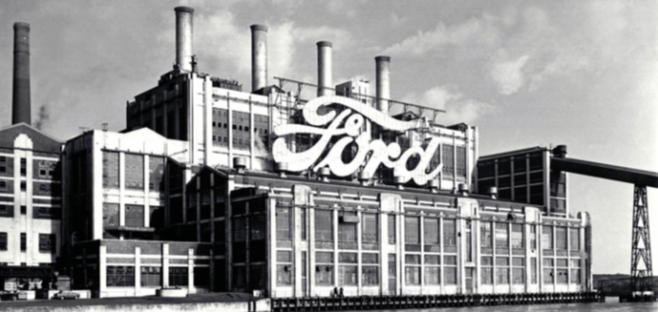The original ‘Tractor Boys’: when a factory team dominated Irish soccer
Published in 20th-century / Contemporary History, Features, Issue 4 (July/August 2015), Volume 23The popularity and success of Fordson FC signalled a shift in the place of soccer within Irish society.
When the Ford Marina plant opened in Cork in 1917, those who started work there would probably not have believed that within a few short years a soccer team from the factory would not only win the Free State (now FAI) Cup but also compete in the Free State League.
So how did the new Ford factory end up with a football team? It was quite common during that era and earlier for large companies to provide for the welfare of their staff through a variety of means, and this often included the provision of sports facilities. In Britain it was developed most famously by Cadbury’s at their workers’ village, Bourneville. The industrial paternalism that informed the provision of the football team at Ford’s in Cork was similar. There was nothing unusual in their choice of game: Ireland is full of soccer teams that still reflect their origins in industry, such as Jacob’s and St James’ Gate (Jacob’s Biscuits and the Guinness brewery respectively) in the south, and Distillery and Linfield (Dunville Distillery and the Ulster Spinning Company) in the north.

The Fordson FC Free State Cup-winning team of 1926.
‘Tractor Boys’
The level of company involvement varied from place to place. Though it is difficult to establish exactly the level of help received by the club at Ford from the management, the relationship between the two seems to have been strong. In Cork the club took the name ‘Fordson’ after the tractor model that was the main output of the plant for the Russian market, and thus they were known by the nickname ‘Tractor Boys’. The name, and nickname, extended their association not just with Ford but also with local production and the output of local workers.
Fordson’s fortunes rose rapidly after their foundation in 1922; they were admitted to the new Free State League (founded in late 1921 out of necessity after the split with the Belfast-based Irish Football Association) in the 1924/25 season after only a few short years playing in the Munster Senior League. This came on the back of reaching the Free State Cup final, in which they lost 1–0 to Athlone Town. Fordson replaced Midland Athletic in the Free State League but their stint was relatively brief, lasting until the end of the 1929/30 season. Although they had their own ground at Ballinlough, they frequently made use of the UCC- run athletics ground at the Mardyke, as the university’s finance committee’s minute books reveal. In that brief period in the late 1920s they were enormously popular with the people of Cork. When they won the Munster Senior Cup against Barrackton in April 1924, the Cork Examiner reported that some 5,000 people were at the game at Victoria Cross.
Won the 1926 Free State Cup
Their single greatest triumph was their Free State Cup victory of 1926. It was hugely important, not only for the club but also for soccer as a new popular pastime in the city of Cork. Soccer was derided by many in the provincial press of Munster as nothing more than a ‘shoneen game’; the popularity of Fordson FC and their victory in 1926 showed the opposite to be true. On the day of the final, St Patrick’s Day, the Cork Examiner was anticipating a huge spectacle, saying that ‘it is expected a record crowd will witness the game, and elaborate arrangements have been made to cope with the gathering’. The Examiner was not alone in its anticipations. The Evening Echo was talking about the match a full week before, with the author reminding us that just ‘a few years ago I scarcely anticipated seeing a soccer club running two trains in a single morning from Cork to the metropolis. I have not yet met the “fan” who is remaining at home on St Patrick’s Day.’ The day after the match, the Cork Examiner ran an extensive column covering the game. The introductory remarks of the piece are especially interesting:
‘The most important event in the soccer world of the Free State, namely the final of the Senior Challenge Cup, took place at Dalymount Park, Dublin, today, the teams engaged being Shamrock Rovers and Fordson. Since the inception of this competition, four years ago, no final has aroused anything like the extraordinary interest in today’s battle. At the moment Association is the most popular game in the Free State, and the teams engaged today represent the cream of its talent.’
An exciting contest for spectators, it finished 3–2 in favour of the Cork side, bringing the FAI/Free State Cup down south for the first time. The Examiner described the scene vividly, saying that
‘. . . the climax was reached when after escaping from the penalty Fordson secured the winning goal. Then hats, caps, sticks, flags, etc. went into the air, and some of the spectators actually rushed on to the ground to congratulate the scorer. When the game ended the overjoyed spectators swarmed over the ground and carried the victorious team shoulder high off the ground.’
Were you eager to relive the day in print, you had to wait until the edition of the following Saturday to get the take of ‘Observer’, Cork’s main soccer correspondent in the Examiner, who described the anticipation of the morning:
‘. . . a train timed to leave the Glanmire terminus at 7.35 was full one hour earlier; but, notwithstanding the discomfort involved, hundreds took up their position in the corridors. The scene at St Patrick’s Church was amazing, hundreds being unable to gain admittance to the special Mass which by the kindness of the Dean was celebrated at 6.45.’
The game over, the crowds made their way back to the train station, the scene one of pandemonium. ‘Observer’ notes that ‘the Fordsonian following swelled the number to big proportions, traffic being completely held up at the station premises for some time’. He wrote that the victory ‘was certainly unique for Cork soccer’ before noting that, ‘being one of the old contemptibles, I felt glad to have been alive to see the day a Cork club won the blue riband of Association Football’. The Football Sports Weekly correspondent for Munster wrote after the victory that ‘never since the days of the old political leaders has such a vast throng turned out to give a spontaneous welcome to a man or a body of men’.

Ford’s plant in Dagenham, which opened in 1931. Many workers subsequently moved there and were referred to in Cork as ‘Dagenham Yanks’.
A shift in attitudes towards soccer
Such coverage signified a shift in the place of soccer within Irish society. In Cork, a city and county that had been the focus of much of the War of Independence and the subsequent Civil War, such a shift was significant. Those who a few short years before had been regarded as ‘contemptible’ for playing soccer were now being celebrated very openly for their victory by thousands in the streets. That the cup final was played on St Patrick’s Day is significant, too, suggesting a move away from soccer’s military origins and alignment with the new and distinctly Catholic Free State, to say nothing of a shrewd business move to hold the final on a major public holiday. Even the holding of an early Mass before the match in Cork suggests a shift from a hard-line anti-‘foreign games’ mentality to one that was more accepting of soccer’s place as one of the most popular sports in Ireland. Of yet further significance is the crowd that attended the game, roughly 25,000 people. In the same year, only marginally more attended the All-Ireland hurling final that saw Cork win for the first time since 1919.
‘Dagenham Yanks’
Mr Jack Kelly presented the man-aging director of the plant, Mr Edward Grace, with the match ball. Mr Grace said that ‘he felt very proud of them and so did the firm, whose hearty support the Cork factory would always have’. Significantly, the team’s victory photograph shows them in front of a background that includes the Marina plant. Yet within a few years the club ended its association with the Ford factory after the 1929/30 season to become Cork FC, just as things were souring in the plant with the opening of the new Ford factory at Dagenham. As Nyhan notes, many workers moved to Dagenham and were referred to locally as ‘Dagenham Yanks’. In 1932 the local soccer column of the Evening Echo noted that
‘. . . in addition to the toll taken by unemployment, a transfer of Fordson workers this week has further depleted the ranks of soccer fans and players of Cork. With general regret leave was taken of Mr Robert McClaverty, a popular referee at the meeting of referees last weekend. Mr McClaverty has gone to Dagenham. Before he left he paid tribute to soccer players and followers in Munster for their general sportsmanship, and said he was sorry to be leaving the country . . . Four junior players have also left this week for Dagenham.’
Indeed, ‘Shandon’ noted that ‘there are almost sufficient in the [Dagenham] Ford works there now to form a Cork team’. He goes on to encourage this by suggesting that ‘this would not only keep them fit, heighten their lives in their new surroundings, but help to keep the name of Cork to the fore, and forge a further link with their native city’.
An important force in Cork footballing circles, Fordson brought the city its first real success in the game and made it not only more popular but also more acceptable, something with which people could feel proudly connected even beyond Cork.
David Toms’s Soccer in Munster: a social history, 1877–1937 will be published shortly by Cork University Press.
Further reading
S. Jones, Workers at play: a social and economic history of leisure, 1918–1939 (London, 1986).
M. Nyhan, Are you still below? A history of the Ford Marina plant, Cork, 1917–1984 (Cork, 2007).
















